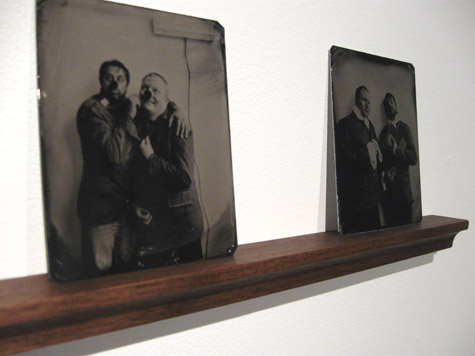
EXPLORING DARK TIMES Tintypes of provocateurs. Photo: COLE CASWELL |
Bertolt Brecht asks, "In the dark times, will there also be singing? Yes," he answers, "there will be singing. About the dark times." But removed from the dark times, when gathered at a glowing walnut table enjoying lamb stew and zinfandel with friends and affable strangers, can we hear that singing? What if there is a glowing neon light reading "Dobranoc Warszawa" (good night Warsaw) beside the table, or execution hoods propped on a nearby block? Can we empathize with, or integrate, or revere that singing? Certainly not at the dinner table! With such good company?
There is a single table in Whitney Art Works, with built-in baskets for bread and benches built for two, where audiences of 10 will enjoy "Dual Site: A Psychogeographic Dinner Theater" in three acts. Complete with candles and wine, it is very romantic and intimate, and quickly your neighbors are friends. Before the performance begins, Leon Johnson, a South African multi-media artist and educator, introduces the project. Passionate and charming, he asks, can we give ourselves problems worth having?
Presently, two actors enter the room's consciousness: Peter Brown and Dennis St. Pierre, sitting at a mirror, primping one another. A projection appears on the wall, an unsettling abstraction of human figures and static, and the first act commences, a stoic reading of excerpts from the journals of the Goncourt brothers, Parisian thinkers of the mid-1800s. The actors hover close to the dinner table, in ambiguous continental accents delivering monotonous observations and anecdotes of Parisian society, of an American god, of malaise, of despair, and lack of integrity, interspersed with sardonic quips. The performance is flat here, confronting the audience with words only, which some choose to stay engaged with, while others might pour more wine, or indulge in camembert. It is during this first act that the participant/observer role of the audience becomes clear — sitting at the table, we are also on stage. The tension of conviviality, the distraction of the wafts of dumplings or tom kha (excellently prepared by Johnson), and our discomfort at subjects presented — all that is the actual performance. This is emphasized by the sudden awareness that we are only 10, perhaps outnumbered by the company watching from the sidelines.
The lamb stew came not a minute after the end of the first act. Silence was heavy among the audience, adjusting to the nature of the evening. The situationist concept of psychogeography, the exploration of the effects of an environment on the experience of individuals (and any play with variables therein) is in full swing here, as the audience navigates a thoroughly curated environment.
The actors bumble onto the set for the second act, an absurdist carnival of Beckett persuasion. Adapted from a short play by Andrei Amal'rik, a Russian dissident, the two actors giddily whine about consumer decisions and identity, playing manipulator and victim. The performance becomes more directly provocative, or perhaps invasive, as the actors sit at the dinner table, touch the audience, gaze deeply into eyes, and proclaim love for an audience member.